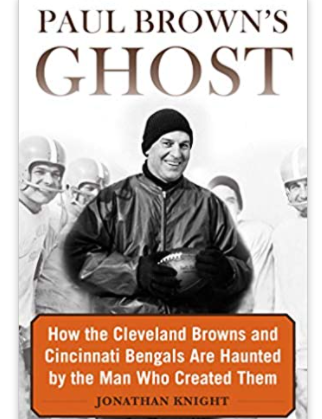As pointed out in past posts, there are a handful of people that stand out for their overwhelming contributions to the game that have made American Football one of the greatest games of sports to watch and participate in. Paul Brown, the legendary high school, college, and professional coach/executive, fits this mold. We went back to our Pigskin Dispatch audio archives in interviews with experts on Coach Brown: Jonathan Knight, Greg Tranter, Ken Crippen, and George Bozeka to help us understand the legend of Paul Brown.
Paul Brown Audio Documentary
Introduction to the early years of Paul Brown
Born September 7, 1908, in Norwalk, Ohio, was Pro Football Hall of Fame innovator, executive, and Coach Paul Brown.
His father was a railroad dispatcher in town but soon transferred to Massillon, Ohio. The younger Brown shortly thereafter enrolled at the local Washington High School in Massillon. At WHS, Brown played football, basketball, baseball and also ran track. He was soon entrenched as the starting quarterback; Brown led the Tigers to a 15-3 record in two years.
College Play and Early Coaching of Paul Brown
Paul Brown enrolled at Ohio State University, dreaming of suiting up for the Buckeyes football team. However, this dream ended abruptly when an assistant coach told him he was too small and was not even allowed to try out for the team. His time in Columbus only lasted one year, and he transferred to Miami University that next fall.
Fortunately for Brown, Chester Pittser and the Miami coaching staff did not find him to be too small and allowed him onto the team. Due to injuries, Brown was named the starting quarterback in his junior year and never let go of it. He guided the Redskins to records of 6-2 as a junior and 7-2 as a senior.
In 1930 he moved from Oxford to Maryland to teach/coach at Severn Prep High School
During the 1931 season, Brown earned the head coaching job at his alma mater Massillon High School. While at Massillon, Brown invented the playbook and was the first to use hand signals to call plays. The signals later led to a person-to-person system of having a player (often linemen) shuttling the offensive plays into the quarterback.
Brown Moves up a level
Coach Brown became the youngest coach in Big Ten history when he took over as head coach of Ohio State University in 1941. Brown led the Buckeyes to their first-ever National Championship in his second season at Ohio State.
During war time in 1943, Brown took over the coaching duties of the Great Lakes Naval Academy, in Chicago. In his two years at Great Lakes, his teams went 15-5-2 with a memorable victory over Notre Dame in 1945. While in Chicago, Brown was stationed with future successful head coaches Weeb Ewbank, who served on his coaching staff, and Ara Parseghian and Bud Grant, both players on the team.
1946 - All American Football Conference (AAFC) in
At the end of his tenure with Great Lakes, Arch Ward approached him with the opportunity of coaching in the new AAFC. The Cleveland franchise originally wanted Notre Dame Head Coach Frank Leahy, but were denied. They may not have been sorry when Brown accepted the role. By the time Brown arrived in Cleveland, the team had signed a number of players to its roster. Brown had a great memory and brought in players that he had seen before. Men from Ohio State, Great Lakes and Massillon teams that Brown coached including:
- Quarterback Otto Graham, whose Northwestern squad had beaten the Buckeyes in 1941.
- Lou Groza, a placekicker and tackle, played for Brown at Ohio State before the war intervened.
- Receiver Dante Lavelli was a sophomore on Ohio State's championship-winning team in 1942.
- Bill Willis, a defensive lineman whom Brown coached at Ohio State.
- Marion Motley, a running back who grew up in Canton and played for Brown at Great Lakes.
Willis and Motley became two of the first black athletes to play professional football when they joined the team in 1946.
During the AAFC’s four seasons, the Browns of Paul Brown won the AAFC league championship all four years, 1946-1949 and registered a stellar total record 52–4–3.
Leaving Browns, the AFL, Bengals, and Beyond
In 1962, due to conflict with Cleveland Browns' new owner Art Modell, Paul Brown was fired as the head coach. In his 17-season tenure with the Browns, the franchise under Coach Brown accumulated a record of 158-48-8, with seven league championships and 11 division titles.
The Bengals franchise opened shop in the AFL in 1967 and played their first game in 1968. Two years later, the ten American Football League teams would merge with the NFL. Brown was not only the owner, but he would serve as the team's head coach for six seasons in the NFL. Coach Brown went 48-36-0 during that time, and the Bengals won two division titles.
In 1975 Brown stepped down as the Cincinnati Bengals' head coach but remained an active owner.
Paul Brown left this world in 1991, remembered as the football legend that he was.
More info on our guests
George Bozeka, a football historian who has resided in the Stark County area for his entire life, has admired the importance of this great contributor, Coach Brown.
Historian Ken Crippen, founder of the Football Learning Academy grew up with a passion to the roots of football and his research and knowledge are well reknown.
Greg Tranter has written the Buffalo Sports Curse and Relics along with another book that is not strictly football, but is all Buffalo Professional Sports from 1857 to the present. It covers all of Buffalo’s professional football teams including the 1920’s All Americans the 1940-41 Tigers/Indians and the Bills/Bisons of 1946-49, plus the current day Bills. The book is titled: Makers, Moments and Memorabilia: A Chronicle of Buffalo Professional Sports . Just click on the link of the title to get a copy of that one.
Ken Crippen
The bio of the gridiron historian, author, and founder of the Football Learning Academy, Ken Crippen, as found on the FLA website.Jonathan Knight
A bio on the works of writer Jonathan Knight, author of Paul Brown's Ghost, and numerous other titles.George Bozeka - The Official PFRA Podcast
Co-Host George Bozeka of the The Official PFRA Podcast which is part of the Sports History Network, is a longtime gridiron historian, President of the Professional Football Researchers Association and author of multiple titles.Greg Tranter
Historian and author Greg Tranter is a major fan and collector of Western NY and Buffalo Bills football history.Author Jonathan Knight
We are truly privileged in this edition of the Pigskin Dispatch Hame Changers series to have a sportswriter from Ohio that has written ten books on Cleveland Sports, Jonathan Knight. Today we will focus on his book, Paul Browns Ghost.
Jonathan Knight has written ten books on Cleveland sports. Called "one of the most articulate and devoted sportswriters in Ohio" by the Akron Beacon Journal, Knight has been praised by the Plain Dealer, Cleveland Scene, Cleveland Magazine, and ESPN's Grantland.com. He's a graduate of Ohio University's E.W. Scripps School of Journalism and a member of the Society for American Baseball Research. He lives in Columbus, Ohio, with his two sons.
Today we are going to focus in on the author's book titled, Paul Brown's Ghost.







